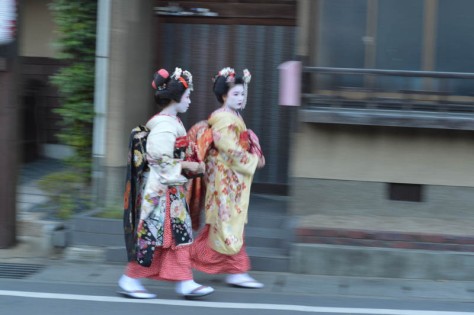One of the most enigmatic and alluring symbols of Japan, besides Mt Fuji and cheery blossoms, are the Geishas. These are women whom had gone through rigorous apprentice training in the fine arts of dance, music and as a hostess. These arts are centuries old and some with notorious connotations or inferences. Let’s get this right. Geishas are not prostitutes. In early history, now outlawed, “pleasure quarters” were established by the regime which included sex. These were never part of the ‘hanamachi” world. Incidentally, the first geisha were men dressed as women.
Geishas are immaculately dressed and made up from head to toe. The most striking features are their white painted faces, flowing intricately designed silk kimono and their dainty footwear. Their hair-dos, accessories and just their mere presence, fills up the area. Not only the foreigners, even the local Japanese, both men and women, seemed infatuated by them.
Geishas are single women, living, learning and working in a strictly matriarchal society under the guidance and care of the house mother, the “okāsan”. The lodging for the geisha and maiko is the “okiya” where they will spend their life. Many women run and manage the tea houses, “ochaya”, where the geisha perform. The area where they live and perform is referred as “hanamachi – flower towns”.
In Kyōto, the most number of geisha in the country, numbering less than 2000, are found. They are called “geiko” and the apprentice is “maiko”. The most popular ‘hanamachi” districts are Gion, Pontochō and Miyagawa- chō.
Seeing a geisha or a maiko is a privilege in my opinion akin to climbing Fujisan. They do leave a lasting impression after they are long gone. Well at least it did for me.
“The geisha system was founded, actually, to promote the independence and economic self-sufficiency of women. And that was its stated purpose, and it actually accomplished that quite admirably in Japanese society, where there were very few routes for women to achieve that sort of independence”.– Mineko Iwasaki, Geisha, A Life
“Geishas are not submissive and subservient, but in fact they are some of the most financially and emotionally successful and strongest women in Japan, and traditionally have been so.”
— Mineko Iwasaki, Geisha, A Life
Map of Kyoto



Very pretty picture and very informative text ^^ However the two ladies you photographed are young ladies who paid a studio to dress them up as maiko. It’s a popular tourist activity around areas like Kyoto and while the studios can do a very good job, they do get a few thing wrong.
I had no idea at that time whether they were real or “wannabe” geisha. I must admit, they were beautiful and the local Japanese people around seemed to be intrigued as well and surrounded and photographed them too. The next day, a restaurant chef “confirmed” that I had indeed witnessed a geisha. He got out a book, which I suppose like an address book of geisha. Real of not, that evening I was very impressed with them. Thanks for your comment.